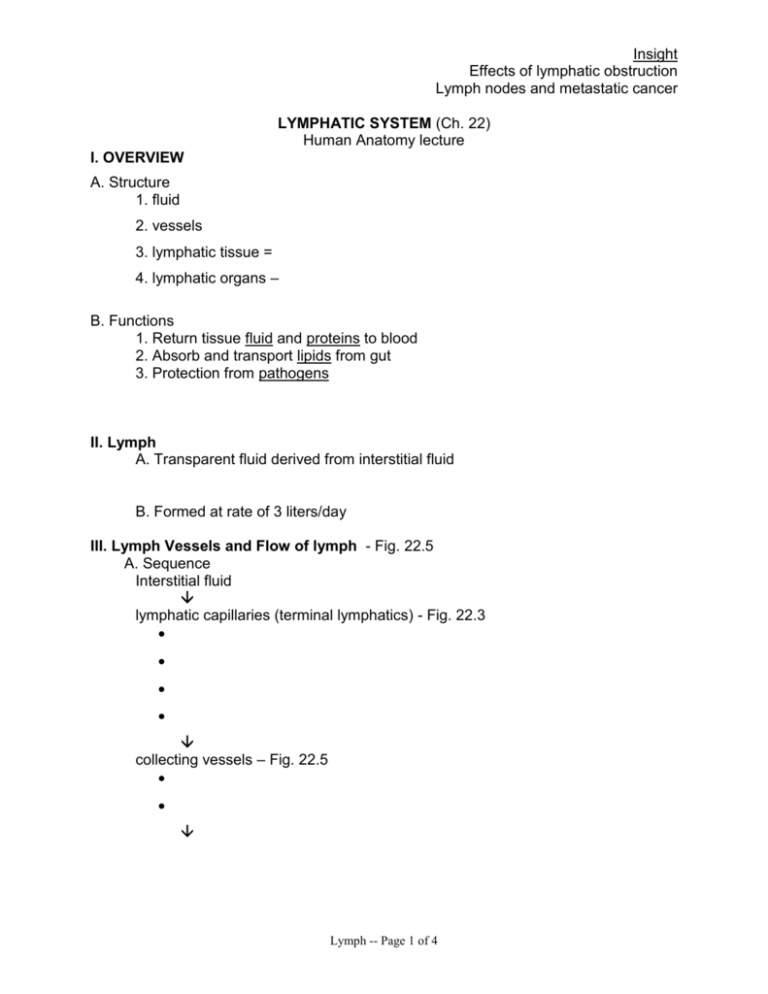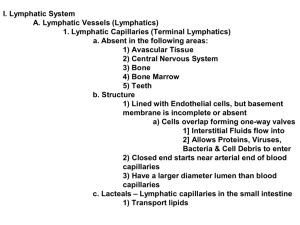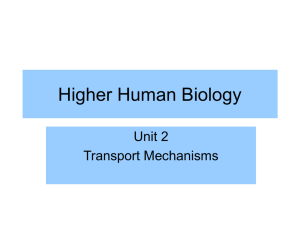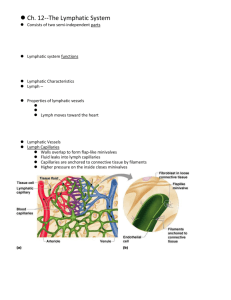LYMPHATIC SYSTEM
advertisement

Insight Effects of lymphatic obstruction Lymph nodes and metastatic cancer LYMPHATIC SYSTEM (Ch. 22) Human Anatomy lecture I. OVERVIEW A. Structure 1. fluid 2. vessels 3. lymphatic tissue = 4. lymphatic organs – B. Functions 1. Return tissue fluid and proteins to blood 2. Absorb and transport lipids from gut 3. Protection from pathogens II. Lymph A. Transparent fluid derived from interstitial fluid B. Formed at rate of 3 liters/day III. Lymph Vessels and Flow of lymph - Fig. 22.5 A. Sequence Interstitial fluid lymphatic capillaries (terminal lymphatics) - Fig. 22.3 collecting vessels – Fig. 22.5 Lymph -- Page 1 of 4 lymph trunks – 9 (not 6 as in your text) –needn’t learn names Fig. 22.6 3 3 3 form cisterna chyli (~L2) right lymphatic duct -- expanded inferior end of the thoracic duct – very short -- receives 3 trunks from below diaphragm -- receives 3 trunks from right side of body thoracic duct (left lymphatic duct) above diaphragm -- continuation of cisterna chyli -- drains into right subclavian vein --receives 3 trunks from upper left side --drains into left subclavian vein lymph returned to blood at R. & L. subclavian veins B. Flow powered by 1. rhythmic contractions of smooth muscle in vessel walls 2. 3. IV. Lymphatic tissues (NRF cells) A. diffuse lymphatic tissue -- MALT (Mucosa Associated Lymphatic Tissue) B. lymphatic nodules -- denser masses, -- appendix, tonsils, V. Lymph organs (well-defined sites, c.t. capsules) A. Primary lymphatic organs: produce B & T cells (WBCs) 1. red bone marrow -2. thymus gland – Fig. 18.5 -- bilobed, superior mediastinum, -- largest at puberty, -Lymph -- Page 2 of 4 B. Secondary lymphatic organs : site of most immune responses 1. lymph nodes – Fig. 22.11 (NRF details) -- arranged like beads on a lymphatic string -- superficial (in subcutaneous tissue) & deep (between muscles)groups -- parietal & visceral groups in body cavities -Sketch- cortex (“bark”) & medulla c.t. trabeculae extend inward from capsule afferents in; efferents out (at hilum) valves force one-way flow sinuses (sinusoids) slow and trap pathogens -- node function: filter lymph reticular c.t. traps pathogens WBCs attack & destroy activate T & B cells 2. spleen --largest lymphatic organ; L. hypochondriac against diaphragm --structure: -sketch- --c.t. capsule & trabeculae --no afferents (only efferents) --hilum w/large splenic a & v -- blood sinusoids Lymph -- Page 3 of 4 --functions -- filters blood: --stores platelets -- produces blood cells in fetus (and adults?) 3. Tonsils – Fig. 22.13 – form protective ring at back of oral cavity pharyngeal tonsil [adenoids](1) – palatine tonsils [“tonsils”](2) – lingual tonsils (?) – Lymph -- Page 4 of 4







